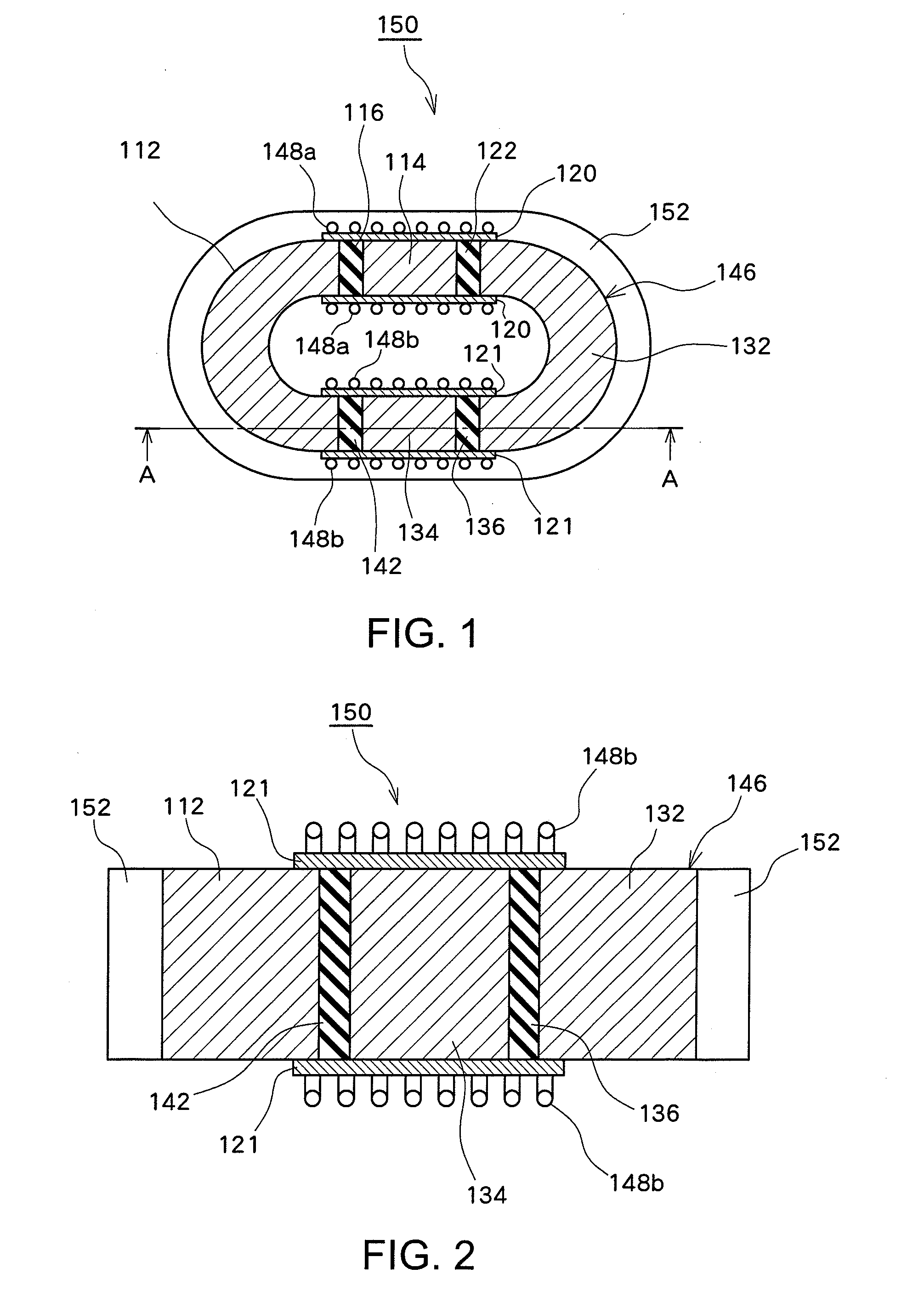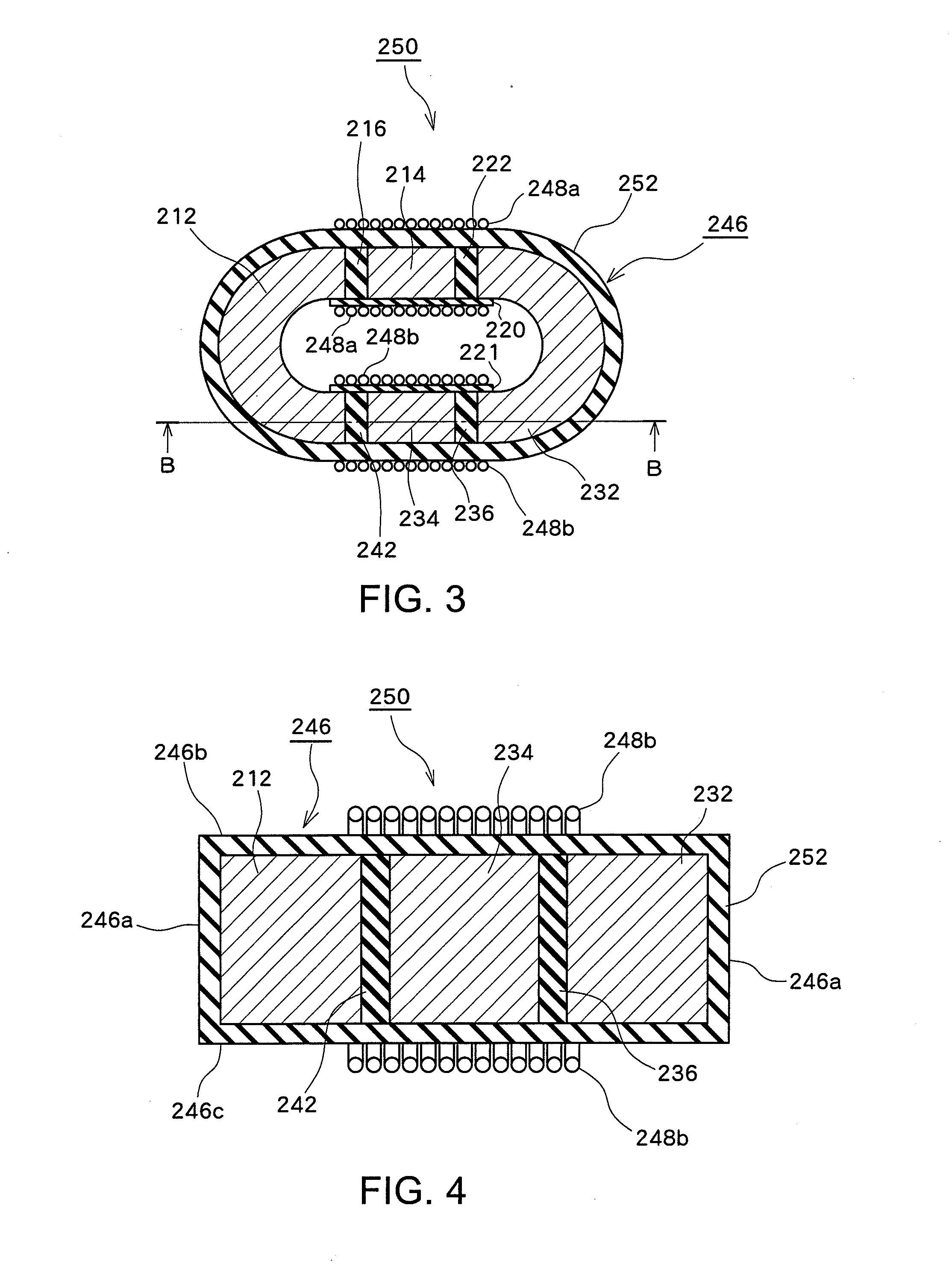Reactor core and reactor
a reactor and core technology, applied in the field of reactors, can solve the problems of large vibration generation, noise and peeling of at least a part of the adhesion surface, and the strength of the core material itself is generally lower
- Summary
- Abstract
- Description
- Claims
- Application Information
AI Technical Summary
Benefits of technology
Problems solved by technology
Method used
Image
Examples
embodiment 1
[0042]FIG. 1 is a view schematically illustrating a structure of a reactor according to an embodiment of the present invention. In FIG. 1, a reactor 150 has substantially the same structure as that of the conventional reactor 50 illustrated in FIG. 9(d) except that the reactor 150 includes a resin 152. Specifically, the reactor 150 includes an annular core 146 formed of a plurality of core materials connected with each other via spacers, and coils 148a and 148b provided on the outer peripheral surfaces of coil bobbins 120 and 121, respectively. The core 146 includes U core materials 112 and 132 having a predetermined thickness, and I core materials 114 and 134 having the same thickness as the U core materials. End surfaces of adjacent core materials are bonded together via spacers 116, 122, 136, and 142, respectively, having substantially the same thickness as the U core materials and I core materials.
[0043]The resin 152 functions as a holding material which holds the core materials...
embodiment 2
[0046]FIG. 3 is a view schematically illustrating a structure of a reactor according to another embodiment of the present invention. In FIG. 3, a reactor 250 has substantially the same structure as that of the conventional reactor 50 illustrated in FIG. 9(d) except that the reactor 250 includes a resin 252 and coil bobbins 220 and 221, in spite of the coil bobbins 20 and 21. Specifically, the reactor 250 includes an annular core 246 formed of a plurality of core materials coupled with each other via spacers, and coils 248a and 248b provided on the outer peripheral surface of core 246. Further, the core 246 includes U core materials 212 and 232 and I core materials 214 and 234. End surfaces of adjacent core materials are bonded together via spacers 216, 222, 236, and 242.
[0047]In this embodiment, the coil bobbins 220 and 221 are integrally molded with the resin 252 using the same resin material as the resin 252. The coil 248a is provided by winding around the coil bobbin 220 and a po...
embodiment 3
[0052]FIG. 5 schematically illustrates a structure of a reactor according to another embodiment of the present invention. In FIG. 5, the shape of a reactor 350 is substantially the same as that of the reactor 250 illustrated in FIG. 3, except that in the reactor 350, a resin 352 is used in place of the resin 252.
[0053]Referring to FIG. 5, the resin 352 differs from the resin 252 of FIG. 3 in that the resin 352 covers only a part of the outer periphery 346a of the core 346. Specifically, while a cross sectional shape of the reactor 350 taken along line D-D is substantially the same as the cross sectional shape of the reactor 250 in FIG. 4, a cross sectional shape of the reactor 350 taken along line C-C in FIG. 5 differs from the cross sectional shape illustrated in FIG. 4. More specifically, the resin 352 covers a part of the outer periphery 346a of the core 346 to thereby support at least a part of the core materials in the vertical direction with respect to adhesion surfaces betwee...
PUM
| Property | Measurement | Unit |
|---|---|---|
| particle size | aaaaa | aaaaa |
| temperature | aaaaa | aaaaa |
| temperature | aaaaa | aaaaa |
Abstract
Description
Claims
Application Information
 Login to View More
Login to View More - R&D
- Intellectual Property
- Life Sciences
- Materials
- Tech Scout
- Unparalleled Data Quality
- Higher Quality Content
- 60% Fewer Hallucinations
Browse by: Latest US Patents, China's latest patents, Technical Efficacy Thesaurus, Application Domain, Technology Topic, Popular Technical Reports.
© 2025 PatSnap. All rights reserved.Legal|Privacy policy|Modern Slavery Act Transparency Statement|Sitemap|About US| Contact US: help@patsnap.com



